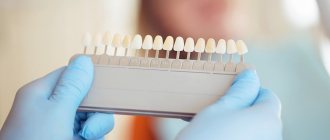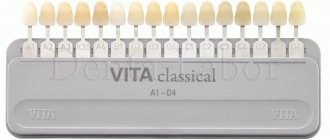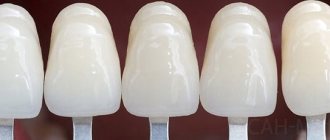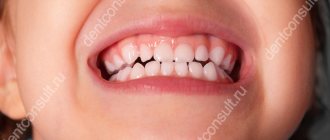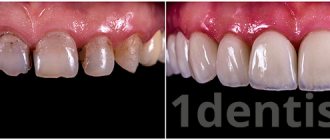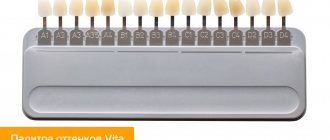Natural color is milky white, slightly translucent. If the teeth are snow-white, the dentist has intervened; such tones are not present from birth. The shade depends on dentin and enamel. In a person's youth, the enamel layer is stronger. The dentition looks whiter if the enamel layer is dense and does not allow light to pass through. This is achieved by removing irregularities.
With age, teeth wear down, the surface becomes smoother, light passes through more easily, which makes the image dimmer. The enamel becomes brown, yellow, black or gray. Different parts of the structure have different colors. A light shade predominates on top, a dark shade on the bottom. But each person has his own natural tone - this is normal.
Author of the article: Shirokov Ivan Yurievich
Work experience:
15 years
Specialization:
Dentist-orthopedist
Works:
at the clinic on Butyrskaya metro station
What do natural teeth look like?
Innate color depends on:
- genetic factor;
- human habitat;
- skin color, race.
There is a common belief that black people have a white smile. This is a fallacy, an optical illusion. Their smiles appear brighter against dark skin backgrounds. If you compare the jaws of an African American and a Slav, the result is the same. This phenomenon is found in tanned people. If a person lies in the sun for at least an hour, this is enough to transform his smile.
Professional scales and templates used in dentistry
Professional scales are usually produced by composites manufacturers. They are plates with samples of shades (teeth) made of ceramic, cardboard or plastic. Ceramic samples are considered the most accurate, since they are similar in properties to natural enamel, which means they refract and reflect light in a similar way.
One of the most frequently used is the Vita scale [2]. They are used to determine color in the manufacture of veneers, crowns, dentures, as well as when assessing the results of lightening in professional whitening. The shades in them are grouped into four groups:
● A – reddish-brown;
● B – reddish-yellowish;
● C – gray;
● D – reddish-gray.
In addition to the Vita scale, there are others, for example: GUMY, Chromascop, Vitapan 3D Master and so on [3]. There are also systems that are used exclusively in hardware methods.
How is teeth color determined?
Dentists define it according to one principle. There is a Vita scale that divides varieties according to shade range:
- brown;
- grey;
- yellow;
- red.
There is no white: it is an unnatural phenomenon created by technology.
The degrees of shades are divided into 4 ordinal levels. O is not on the table. The Latin letter "A" is red-brown. The higher the number in the index, the darker the enamel:
- light teeth - “A1”;
- darker - “A2”;
- even darker - “A3”;
- very dark - “A4”.
Yellow - Latin "B". There is a gradation from 1 to 4. The gray shade is characterized by the indices “C1”, “C2” and further down the list. The red-gray surface on the Vita scale is designated by the Latin letter “D”.
Tone selection features
When contacting dentists regarding prosthetics and teeth whitening, it is strongly recommended to conduct a comparative analysis using the classic Vita colors. The most popular today are instruments manufactured by the manufacturer Ivoclar Vivadent (Liechtenstein), the slats of which include the lightest shades from groups A, B, C and D, called Bleach. The average cost of one such palette is about 1,400 Russian rubles.
Instead of such a device, computer technologies can be used, which can also be used to select the optimal tooth color by pre-loading a high-resolution digital photo of the patient into the system. However, as practice shows, carrying out a visual comparison procedure turns out to be more effective and reliable, especially since such a service can be provided in almost any dentistry.
But in order for the final work to look good and the patient not have questions about why during the selection there was one shade, but the result was a completely different one, it is strongly recommended to carry out comparisons under strictly defined conditions. As a rule, we are talking about the following determining factors:
- Before the procedure, a double procedure for cleaning the teeth must be carried out, the first of which is done by the patient himself at home, and the second by the doctor, using a special solution for this purpose.
- The patient is advised to wear clothes in neutral pastel colors (not snug), which will not create unnecessary contrast. Also, white or too brightly colored clothing is not suitable, as it can reflect and refract light, ultimately distorting the doctor’s perception and making a normal result impossible.
- The dental office should have good natural lighting, which can be replaced with high-power fluorescent lamps. In the absence of such equipment, a special frame with LED illumination can be used, which is held by the patient during the procedure so that it can fully illuminate his teeth.
- You can check the color of teeth using the Vita scale only if they are absolutely healthy, since any concomitant disease can negatively affect the natural color of tooth enamel.
Unfortunately, even compliance with ideal conditions is not a 100% guarantee that the match will be perfect, for a number of reasons. Firstly, it is difficult to choose the ideal tone when the patient’s teeth have different colors (in this case, the doctor chooses something in between or recommends correcting the entire smile line to achieve one tone). And secondly, the palette of natural shades is so diverse that it simply by definition cannot be limited to those sixteen shades that are presented in the auxiliary scale.
How to choose a color?
If the patient is going to choose the tone on his own, take into account the conditions that affect the visual component:
- Skin tones. The darker the skin, the whiter the teeth look.
- Hair. Like with skin. Brunettes have a brighter smile than blondes.
- Whites of the eyes. If they are dimmer than the smile area, it looks unnatural and stands out too much when opening the mouth.
- The material from which the dental structure is made. Plastic materials differ from metal ceramics, even with the same index on the Vita scale.
Changes in lighting and dimming distort the perception of colors. The walls in the clinic and the clothes of the dentist and patient should be of a neutral shade. Women are advised to remove lipstick. Sometimes the rest of the cosmetics are removed.
Factors affecting shade
The tones of tooth enamel are individual, they are different for each person. The main factors influencing tone are:
- milk units are characterized by a perfectly white shade, since the enamel is still thin, it visually appears much lighter;
- a grayish tint is usually observed in teeth after depulpation, with fluorosis;
- the yellow tone is most common, it is associated with genetic factors, a thin layer of enamel through which dentin is visible, an increase in the yellow tint is characteristic of age-related changes, violations of hygiene rules, the darkest tone is observed in smokers;
- a brown tint appears with age-related changes; at a young age it is caused by food pigments, when taking drugs of the tetracycline group.
Before prosthetics, it is recommended to restore the natural tone. For this purpose, various bleaching methods are used, and office cleaning is carried out.
To clarify questions about dental restoration, please contact the specialists of the Denta-Labor clinic by calling (495) 162-08-25 . You can also make an appointment at a time convenient for you, for which you need to fill out an application on the website, spending just a couple of minutes.
Where to get prosthetics?
Many clinics provide partial or complete prosthetics services. Find doctors based on reviews. Contact a clinic that has proven its professionalism through experience and work.
A doctor who knows his business will not rest until he brings his smile to perfection. The equipment of the clinic is important. Equipment in the hands of an experienced doctor works wonders. You will get what you expected.
As for the price, it depends on the case. Prices range from 1,700 rubles for simple crowns to 30,000 for lumineers or veneers. The procedure will cost 21,000 apiece.
Restoring lost color
If initially the patient’s teeth were much lighter and brighter, but over time they began to darken and lose their natural shade, you can try to do without expensive whitening and restore the color yourself. Typically, the following techniques give a good effect, provided they are used regularly:
- Quitting bad habits and, first of all, smoking.
- Maintain good oral hygiene, including brushing with fluoride-free whitening toothpastes and rinsing.
- Regular visits to the dentist and timely dental treatment.
- At least temporarily avoid drinks and foods with dyes, caffeine and fluoride.
We should not forget about prevention, which is recommended even if the normal color of tooth enamel is preserved. If all the efforts made were in vain and the smile is still far from ideal, you can resort to more radical measures.
As a rule, we are talking about professional services that include dental cleaning with the removal of stones and accumulated plaque, as well as external or intracanal whitening, which is most often carried out using special chemical solutions based on hydrogen peroxide. The latter procedure is indicated primarily for those patients who have suffered periodontitis (traumatic), and its main disadvantage is the increased sensitivity of the teeth.
If you want to make your teeth perfectly white for the long term, then it is better to resort to installing veneers, lumineers or ultraneers. It should be noted that, in addition to aesthetic indications, such manipulations are relevant for patients whose teeth have darkened due to regular use of medications or after the installation of artificial materials (fillings) that caused a change in color.
A beautiful smile is the key to success!
Smile with us! The dentists at our Center will help you make your smile sparkling for a long time. The department is equipped with the latest technology and has everything necessary to perform high-quality work: a modern dental complex, high-quality X-ray equipment and the latest generation materials. Each patient is guaranteed high-quality treatment and an individual approach to teeth whitening. If, after whitening, you need to replace old fillings with defects with new ones or cure caries, all these problems can also be solved in our dental department.
Remember that beautiful teeth are your calling card in our modern world!
Preventive measures
If over time your smile has yellowed, your teeth have become dull and stained, in some cases you can do without in-office whitening and veneers. To do this, it is enough to undergo a professional cleaning procedure in the dentist’s office and subsequently provide competent prevention:
- give up bad habits, reduce consumption of coffee, strong tea and coloring products,
- maintain a high level of hygiene, brush at least twice a day, rinse your mouth every time after eating, use floss,
- start treatment of emerging dental problems in a timely manner and undergo preventive examinations at least twice a year.
Using hygiene products will help preserve the color of the enamel.
If the cause of the darkening has more serious justifications, you will need to undergo a full diagnosis in order to identify the true causes of the problem and then work directly with them. Professional whitening, microprosthetics or installation of crowns/prostheses will help correct the aesthetic defect.
Features of working with the Vita scale
An experienced dentist who has been involved in dental prosthetics for a long time takes into account all the nuances that influence the selection of the color of future dentures. So, you have to take into account:
- lighting of the dental office;
- background for wall and furniture decoration;
- texture and color of the patient’s clothing;
- human skin tone.
The doctor’s perception is also important: for high-quality work, there should be no “clouding” of the eye, which happens when the examination takes too long.
Conditions necessary for diagnosis
The result of a comparative analysis directly depends on external factors that distort the visual perception of color. Before the testing procedure, it is recommended to thoroughly brush your teeth and remove plaque from the oral cavity. The doctor performs additional sanitation with a special solution.
This treatment eliminates visually indistinguishable microscopic plaque, which changes the shade of the jaw rows. For a dental appointment, it is advisable to wear neutral or pastel-colored clothing with an open neckline so that the fabric does not obscure the surface of the teeth.
Testing is carried out only on completely healthy patients. In case of exacerbation of a chronic pathological process, respiratory diseases or inflammation, a visit to the dentist should be postponed until the physiological state normalizes. The office must have an appropriate level of natural light.
Reasons for changes in enamel color in children
- Some diseases of a pregnant woman: viral or bacterial infections of the mother’s body, as well as some medications (for example, tetracycline antibiotics) leave an imprint on the development of the fetus, including the formation of its tooth buds. This is fraught with the fact that the baby will erupt in units already with a defect (enamel hypoplasia or hyperplasia, tetracycline teeth, etc.),
- initial stage of caries: may change the color of milk crowns (white spots appear on them),
- fluorosis: a surplus of fluoride in a child’s body (due to the large consumption of fluoride-containing products, water, the use of toothpaste with a high content of this element) changes the color of the enamel, it becomes grayer and at the same time rough, brittle, with grooves,
- treatment with iron preparations: if they are used in liquid form, they cause temporary darkening of the tooth surface,
- constant consumption of coloring products: blueberries, bird cherry, sweets and drinks with artificial colors or based on red and blue berries.
Teeth whitening and restoration techniques
If even careful care and regular professional hygiene do not allow you to completely get rid of yellowness, teeth whitening comes to the rescue. In our articles, we have already examined in detail the advantages and disadvantages of office and home whitening.
When darkening of the teeth is caused by severe thinning of the enamel, dental disease, or a general deterioration in the patient’s health, the first step is to correctly diagnose the problem and carry out appropriate treatment. Afterwards, it is possible to restore your smile with the help of veneers, lumineers and crowns.
We recommend that you try your best to keep your teeth healthy.
Advice from Dr. Zubastik
Don't like the color of your teeth? Don't worry, the problem can be solved. If you wish, you can buy a special set of mouth guards and lightening gel and lighten the enamel at home.
But first, consult your doctor: he may advise you to limit yourself to ultrasonic cleaning. In this case, the teeth will become half a tone whiter.
If it’s not enough, use a professional whitening service or install veneers. The main thing is that in pursuit of beauty, do not forget about dental health. Frequent bleaching weakens the enamel. Maybe it’s better to agree with what nature gave - after all, yellowish enamel is really a little stronger than ideal white?
Do you want to lighten your enamel? Watch how it happens:
Tags: Baby teeth, whitening, Teeth color, Vita scale
About the author: Dr. Zubastik
Typically, a toothache begins to subside on the way to the clinic and finally goes away after 10 minutes of sitting in line to see the dentist.
- Related Posts
- What not to do after tooth extraction: 10 anti-tips
- Why get temporary crowns?
- What to do with a lost baby tooth: signs
« Previous entry
Current promotions!
I WANT COLOR A1
Option 1. You are lucky - your teeth are like this by nature.
Take care of them! Regularly undergo comprehensive hygiene procedures and, if possible, try to limit dyes. But nothing lasts forever, and neither does the natural whiteness of teeth. Most likely, this will go away with age, unfortunately.
Option 2. Bleaching. There are several methods, they may have different names, the equipment used and the price, but the principle is the same - the chemical effect on the enamel with derivatives of hydrogen peroxide, with or without the use of a light lamp.
Is it effective? Yes, but under certain conditions: firstly, there should be no fillings or restorations on the front teeth, otherwise they will become noticeable after the whitening procedure and will need to be redone. Secondly, over time, the natural color will return, and bleaching must be repeated. After whitening, teeth can become very sensitive, so much so that repeating the procedure will be impossible. Repeated bleaching severely damages the enamel.
Option 3. Artistic restoration using composite materials. This method is applicable if your teeth are not ideally shaped and have natural wear. The doctor can use light-colored material, but all teeth that are visible when smiling and talking must undergo restoration. The advantages of this “build-up” are that the method is quite gentle, but the disadvantages are a large amount of expensive work and a shortage of specialists who are fluent in this technique. And of course, like everything else, restoration is not eternal.
Typically, tooth enamel is close to milky white in color.
It is also characterized by translucency. And the color of teeth, which we perceive as the color of enamel, is still determined by the color of dentin, because it is this that shines through the translucent enamel.
In young children, tooth enamel is denser and has a more pronounced relief than in adults. It is for this reason that their teeth look whiter and lighter, since the enamel is less visible. Over time, the enamel becomes thinner and smoother due to its contact with food and drinks, so the enamel becomes even more transparent. And then the natural color of dentin appears through it, which can be yellow, brownish, gray.
One should also take into account the fact that the color itself is uneven in its structure. The closer the dentin is to the edge, the lighter it is, and closer to the root the shade darkens several tones. At the same time, different teeth also have different colors, for example, canines, as a rule, are somewhat darker than the incisors. Even if your teeth become increasingly darker with age, you should not worry: all problems can now be easily solved by aesthetic dentistry . For example, ZOOM laser teeth whitening does an excellent job of returning teeth to their white color, and for those who want to hide some defects in parallel with teeth lightening, there are veneers and lumineers .
You can often hear that dark-skinned people have whiter teeth than light-skinned people. However, this is not quite true. The fact is that the bright whiteness of teeth is partly due to the contrast to dark skin. This is why even if you are slightly tanned, your teeth will appear whiter.
Scientists have repeatedly conducted studies regarding the natural, natural color of teeth in different peoples. The results were not surprising - the shade of enamel and dentin is usually determined genetically and is almost not modified in any way under the influence of external factors. The environment in which a person lives affects the color of teeth to a lesser extent than his heredity.
- Promotion
Dental treatment under anesthesia
Promotion for sedation in Moscow!
If you experience: — Severe stress during dental treatment — Fear of the sound of dental instruments — Time-limited visits to the dentist
old price
12 000 ₽
price
5 900 ₽
Free consultation RUB 5,900 for 30 minutes
Limited offer. Sign up for a free consultation. There are contraindications, consultation with a specialist is required.
- Promotion
Teeth whitening ZOOM
Promotion for teeth whitening in Moscow!
As a gift: - Prof. Oral hygiene – Whitening care set with individual trays
old price
40 000 ₽
price
19 900 ₽
Free consultation Sign up for a free consultation. There are contraindications, consultation with a specialist is required.
When doing prosthetics and dental implantation, the doctor is faced with the task of correctly selecting the shade of the tooth. Of course, the new tooth should not stand out too much in the row, attracting the attention of others. To determine the shade, the so-called Vita scale is used - it is used to create orthopedic structures and to select veneers and lumineers.
The scale itself is a small rail on which samples are attached. These samples are usually made of plastic or metal-ceramic, the latter being considered the best for shade selection as they have the same shine as natural teeth and therefore reflect the color appropriately. The gradation of samples is carried out on a scale from A to D, where the letter A denotes reddish-brown shades, and D – reddish-gray. Next to each letter there is a number from one to four; it indicates the brightness level; the lower the number, the brighter the shade.
Reasons for changes in tooth shade in adults
- violation of the rules of brushing teeth at home: irregularity, unsuitable toothpaste or brush,
- hereditary reasons
- the richness of the daily menu with pigmented products: black berries, strong black and red tea, coffee without milk, red wine, ketchup, soy sauce, etc.,
- smoking: gives a yellow or even gray-yellow coating,
- With age, dentin darkens and enamel becomes thinner: therefore, crowns acquire a darker shade than in youth - due to translucent dentin. Thinning of the enamel due to metabolic disorders also leads to a change in the color of the unit, because dentin is naturally yellow,
- deficiency or surplus of certain vitamins or microelements: zinc, fluorine, iron in the body,
- the presence of an old filling: often its elements penetrate into the dentin over time, oxidize and color it gray or red, which affects the external shade,
- microrelief of the crown surface: the more pronounced it is (grooves, pits, roughness), the darker the crowns appear.
Attention! After professional teeth cleaning (without bleaching), crowns may become a shade or even two lighter. This happens because the hygienist removes plaque, which gives a darker color, grinds and polishes the teeth, leveling the microrelief.
Ways to prolong the results of dental correction
After the procedure of dentures, professional whitening, installation of veneers, it is necessary to follow the recommended care measures. Daily sanitation of the oral cavity with rinsing solutions is indicated. It is not recommended to use an electric or ultrasonic brush.
The impact of devices whose working head rotates at high speeds heats up aesthetic overlays or microprostheses, accelerating their destruction. Such brushes provoke peeling of the adhesive organic substance and reduce the service life of the orthopedic structure.
The whitening procedure using the Vita scale thins tooth enamel and increases susceptibility to external irritants. For care, use special pastes with a gentle composition. To preserve the natural color of your teeth, periodic visits to the dentist for professional cleaning are recommended.
